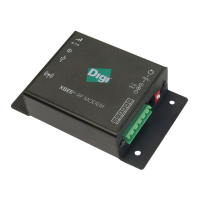XBee® Wi-Fi RF Modules
© 2013 Digi International, Inc. 32
The API provides an alternative means of configuring modules and of routing data at the
local host application layer. A local host application can send data frames to the module
that contain address and payload information instead of using command mode to
modify addresses. The module will send data frames to the application containing status
packets; as well as source, and payload information from received data packets. The API
operation option facilitates many operations such as the examples cited below:
• Transmitting data to multiple destinations without entering Command Mode
• Receive success/failure status of each transmitted RF packet
• Identify the source address of each received packet
A Comparison of Transparent and API Operation
The following table compares the advantages of transparent and API modes of
operation:
Transparent Operation Features
Simple Interface All received serial data is transmitted unless the module is in command mode.
Easy to support It is easier for an application to support transparent operation and command mode.
API Operation Features
Easy to manage data
transmissions to multiple
destinations
Transmitting RF data to multiple remotes only requires changing the address in the
API frame. This Process is much faster than transparent operation where the
application must enter AT command mode, change the address, exit command mode,
and then transmit data. Each API transmission can return a transmit status frame
indicating the success or reason for failure
Received data frames
indicate the sender's
address
All received RF data API frames indicate the source address.
Advanced Networking
diagnostics
API frames can provide indication of IO samples from remote modules, transmission
status messages, and local radio status messages.
Remote Configuration
Set/read configuration commands can be sent to remote modules to configure them
as needed using the API.
As a general rule of thumb, API firmware is recommended when a module:
• sends RF data to multiple destinations
• sends remote configuration commands to manage modules in the network
• receives IO samples from remote modules
• receives RF data packets from multiple modules, and the application needs to
know which module sent which packet
• needs to use the put request and device request features of the iDigi server
If the above conditions do not apply, (e.g. in a sensor node, or a simple application) then
transparent operation might be suitable. It is acceptable to use a mixture of modules
running API mode and transparent mode in a network.

